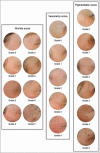The determinants of periorbital skin ageing in participants of a melanoma case-control study in the U.K
- PMID: 21787368
- PMCID: PMC3202027
- DOI: 10.1111/j.1365-2133.2011.10536.x
The determinants of periorbital skin ageing in participants of a melanoma case-control study in the U.K
Abstract
Background: Skin ageing is said to be caused by multiple factors. The relationship with sun exposure is of particular interest because the detrimental cutaneous effects of the sun may be a strong motivator to sun protection. We report a study of skin ageing in participants of an epidemiological study of melanoma.
Objectives: To determine the predictors of periorbital cutaneous ageing and whether it could be used as an objective marker of sun exposure.
Methods: Photographs of the periorbital skin in 1341 participants were graded for wrinkles, degree of vascularity and blotchy pigmentation and the resultant data assessed in relation to reported sun exposure, sunscreen use, body mass index (BMI), smoking and the melanocortin 1 receptor (MC1R) gene status. Data were analysed using proportional odds regression.
Results: Wrinkling was associated with age and heavy smoking. Use of higher sun-protection factor sunscreen was protective (P = 0·01). Age, male sex, MC1R variants ('r', P=0·01; 'R', P=0·02), higher reported daily sun exposure (P=0·02), increased BMI (P=0·01) and smoking (P=0·02) were risk factors for hypervascularity. Blotchy pigmentation was associated with age, male sex, higher education and higher weekday sun exposure (P=0·03). More frequent sunscreen use (P=0·02) and MC1R variants ('r', P=0·03; 'R', P=0·001) were protective.
Conclusions: Periorbital wrinkling is a poor biomarker of reported sun exposure. Vascularity is a better biomarker as is blotchy pigmentation, the latter in darker-skinned individuals. In summary, male sex, sun exposure, smoking, obesity and MC1R variants were associated with measures of cutaneous ageing. Sunscreen use showed some evidence of being protective.
© 2011 The Authors. BJD © 2011 British Association of Dermatologists.
Figures
Similar articles
-
Does MC1R genotype convey information about melanoma risk beyond risk phenotypes?Cancer. 2010 May 15;116(10):2416-28. doi: 10.1002/cncr.24994. Cancer. 2010. PMID: 20301115 Free PMC article.
-
Is skin ageing in the elderly caused by sun exposure or smoking?Br J Dermatol. 2002 Dec;147(6):1187-91. doi: 10.1046/j.1365-2133.2002.04991.x. Br J Dermatol. 2002. PMID: 12452869
-
Contribution of melanocortin-1 receptor gene variants to sporadic cutaneous melanoma risk in a population in central Italy: a case-control study.Melanoma Res. 2006 Apr;16(2):175-82. doi: 10.1097/01.cmr.0000198454.11580.b5. Melanoma Res. 2006. PMID: 16567973
-
Sunscreen abuse for intentional sun exposure.Br J Dermatol. 2009 Nov;161 Suppl 3:40-5. doi: 10.1111/j.1365-2133.2009.09448.x. Br J Dermatol. 2009. PMID: 19775356 Review.
-
Behavioral Counseling to Prevent Skin Cancer: Systematic Evidence Review to Update the 2003 U.S. Preventive Services Task Force Recommendation [Internet].Rockville (MD): Agency for Healthcare Research and Quality (US); 2011 Feb. Report No.: 11-05152-EF-1. Rockville (MD): Agency for Healthcare Research and Quality (US); 2011 Feb. Report No.: 11-05152-EF-1. PMID: 21542545 Free Books & Documents. Review.
Cited by
-
Combined Forehead and Temporal Lifting: An Innovative Approach to Lanluma V Treatment.J Cosmet Dermatol. 2025 Jan;24(1):e16583. doi: 10.1111/jocd.16583. Epub 2024 Sep 25. J Cosmet Dermatol. 2025. PMID: 39319782 Free PMC article.
-
A systematic review of skin ageing genes: gene pleiotropy and genes on the chromosomal band 16q24.3 may drive skin ageing.Sci Rep. 2022 Jul 30;12(1):13099. doi: 10.1038/s41598-022-17443-1. Sci Rep. 2022. PMID: 35907981 Free PMC article.
-
Defining skin aging and its risk factors: a systematic review and meta-analysis.Sci Rep. 2021 Nov 11;11(1):22075. doi: 10.1038/s41598-021-01573-z. Sci Rep. 2021. PMID: 34764376 Free PMC article.
-
A Genome-Wide Association Study Identifies the Skin Color Genes IRF4, MC1R, ASIP, and BNC2 Influencing Facial Pigmented Spots.J Invest Dermatol. 2015 Jul;135(7):1735-1742. doi: 10.1038/jid.2015.62. Epub 2015 Feb 23. J Invest Dermatol. 2015. PMID: 25705849
-
Clinical efficacy of OS-01 peptide formulation in reducing the signs of periorbital skin aging.Int J Cosmet Sci. 2025 Jun;47(3):455-465. doi: 10.1111/ics.13042. Epub 2025 Jan 9. Int J Cosmet Sci. 2025. PMID: 39788697 Free PMC article.
References
-
- Leyden JJ. Clinical features of ageing skin. Br J Dermatol. 1990;122(Suppl. 35):1–3. - PubMed
-
- Jenkins G. Molecular mechanisms of skin ageing. Mech Ageing Dev. 2002;123:801–10. - PubMed
-
- Green AC. Premature ageing of the skin in a Queensland population. Med J Aust. 1991;155:473–4. - PubMed
-
- Duffy DL, Box NF, Chen W, et al. Interactive effects of MC1R and OCA2 on melanoma risk phenotypes. Hum Mol Genet. 2004;13:447–61. - PubMed
-
- Elfakir A, Ezzedine K, Latreille J, et al. Functional MC1R-gene variants are associated with increased risk for severe photoaging of facial skin. J Invest Dermatol. 2010;130:1107–15. - PubMed
Publication types
MeSH terms
Substances
Grants and funding
LinkOut - more resources
Full Text Sources
Medical


